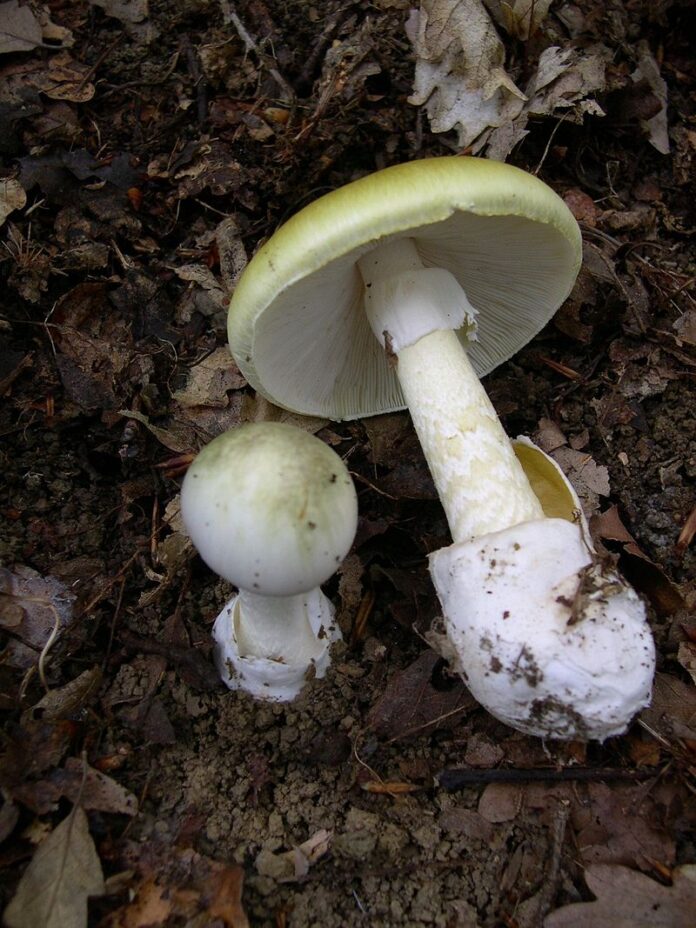Mushrooms are often seen as earthy treat, adding flavor and texture to our favorite dishes. But among the thousands of mushroom species that grow across the world, there lurks a silent killer: the death cap mushroom (Amanita phalloides).
Found all over the world, this death cap (sometimes called the “destructive angel” mushroom) is responsible for the majority (over 90%!) of mushroom poisonings. Its innocent appearance masks a lethal danger.
Identifying the Death Cap Mushroom
The death cap is a deceptively ordinary-looking mushroom. With its smooth, greenish-yellow to pale cap and white gills and stem, it can easily be mistaken for edible varieties such as the paddy straw mushroom or various species of Agaricus. However, that’s why poisonings are so common. One small mistake in identification can have fatal consequences. Eating just have a deathcap mushroom can kill.
The death cap typically grows in the proximity of oak, chestnut, and pine trees, often in temperate regions of Europe, Asia, and North America. It thrives from late Summer through Fall. While some mushrooms emit distinct odors, the death cap smells mild, which betrays its editbility.
The Toxicity of the Death Cap
The death cap mushroom is among the deadliest mushrooms due to the powerful toxins it contains: amatoxins. Amatoxins disrupt crucial biological processes within human cells. Specifically, amatoxins inhibit RNA polymerase, an enzyme vital for the synthesis of proteins in the body. Without this enzyme, cells cannot function properly and die—especially liver and kidney cells..
Delayed onset of symptoms is fatal
After ingestion, symptoms typically do not appear for 6 to 12 hours. The victim may feel the danger has passed. But even as the victim quickly recovers, the mushroom poison is still working.
The early symptoms of deathcap poisoning resemble those of food poisoning, such as nausea, vomiting, abdominal pain, and diarrhea. Unfortunately, after this phase, there is often a deceptive period of apparent recovery, leading victims to believe they are improving. However, this “honeymoon” phase is followed by the return of more severe symptoms as the liver and kidneys begin to fail.
Without prompt medical intervention, death can occur in 50-90% of cases within days. Even for survivors, the risk of permanent liver or kidney damage remains high. Sometimes organ transplant is necessary.
Why the Death Cap is So Lethal
A single death cap mushroom can contain enough toxins to kill an adult. Unlike many toxic substances, cooking, drying, or freezing the mushroom does not reduce its toxicity. The amatoxins are heat stable. Cooking the mushroom by any method does not remove remove the toxins.
One of the most tragic aspects of death cap poisoning is that many victims are experienced mushroom foragers who simply make a single unfortunate mistake. Due to its similarity to several edible mushrooms, even a seasoned forager can accidentally include one in a meal.
Additionally, many people who suffer from death cap poisoning are immigrants who mistake it for edible species from their homeland, where similar-looking mushrooms are common and safe.
Prevent Death Cap Poisoning
There is no simple test to determine whether a mushroom is poisonous. Myths like silver spoons turning black or mushrooms being safe if animals eat them are dangerously misleading. The only surefire way to avoid death cap poisoning is to be extremely cautious when foraging. Or just don’t eat wild mushrooms.
Here are some vital tips to keep in mind:
- When in doubt, leave it out. If you cannot positively identify a mushroom, do not eat it.
- Learn from experts. Join mushroom foraging groups and take the time to learn from seasoned mycologists. The risk is too great to rely on a casual identification.
- Avoid foraging in high-risk areas. The death cap grows in many regions across the globe. In places where it is known to thrive, be extra cautious about collecting mushrooms.
- Educate others. Many people are unaware of the dangers of death cap mushrooms. Sharing information with fellow mushroom enthusiasts and your community can help prevent accidents.
Treatment and Prognosis
The treatment of death cap poisoning depends on how quickly the symptoms are recognized. If you suspect you or someone else has ingested a death cap mushroom, seek immediate medical help. Time is of the essence. The sooner treatment is started, the better the chances of survival.
Medical care typically includes aggressive rehydration, medications to bind the toxins, and supportive care for organ function. In severe cases, liver transplants may be necessary. Early recognition and immediate hospitalization are crucial for improving survival rates. There is no antidote currently.
Conclusion: Respect Mushroom Power
The death cap mushroom is a stark reminder of nature’s cruelty. Foraging for wild mushrooms can be an enjoyable activity, but it carries inherent risks, and none are more serious than the danger posed by the death cap. By exercising caution, educating ourselves and others, and respecting the potent toxins found in some of nature’s offerings, we can continue to enjoy the natural world while staying safe.



